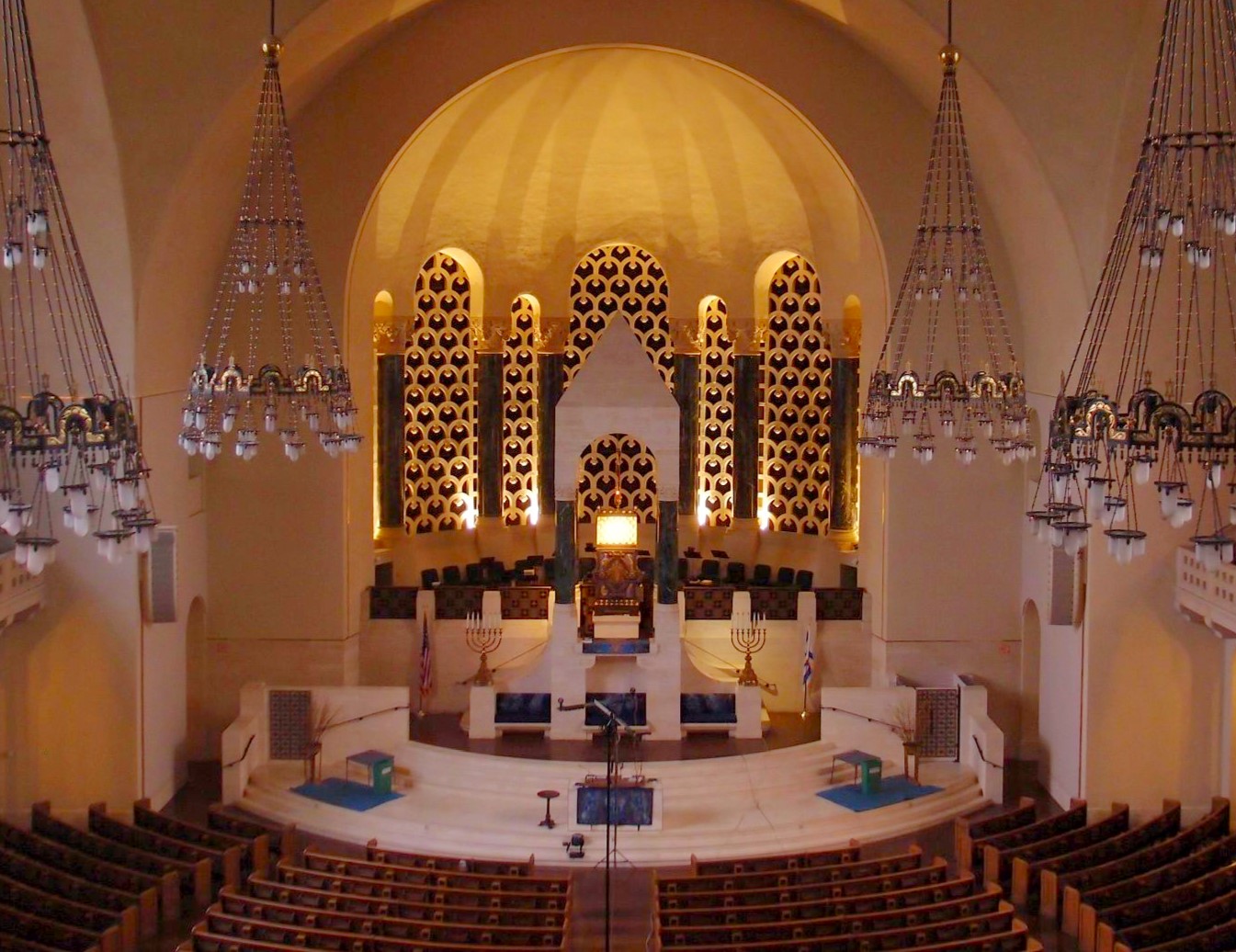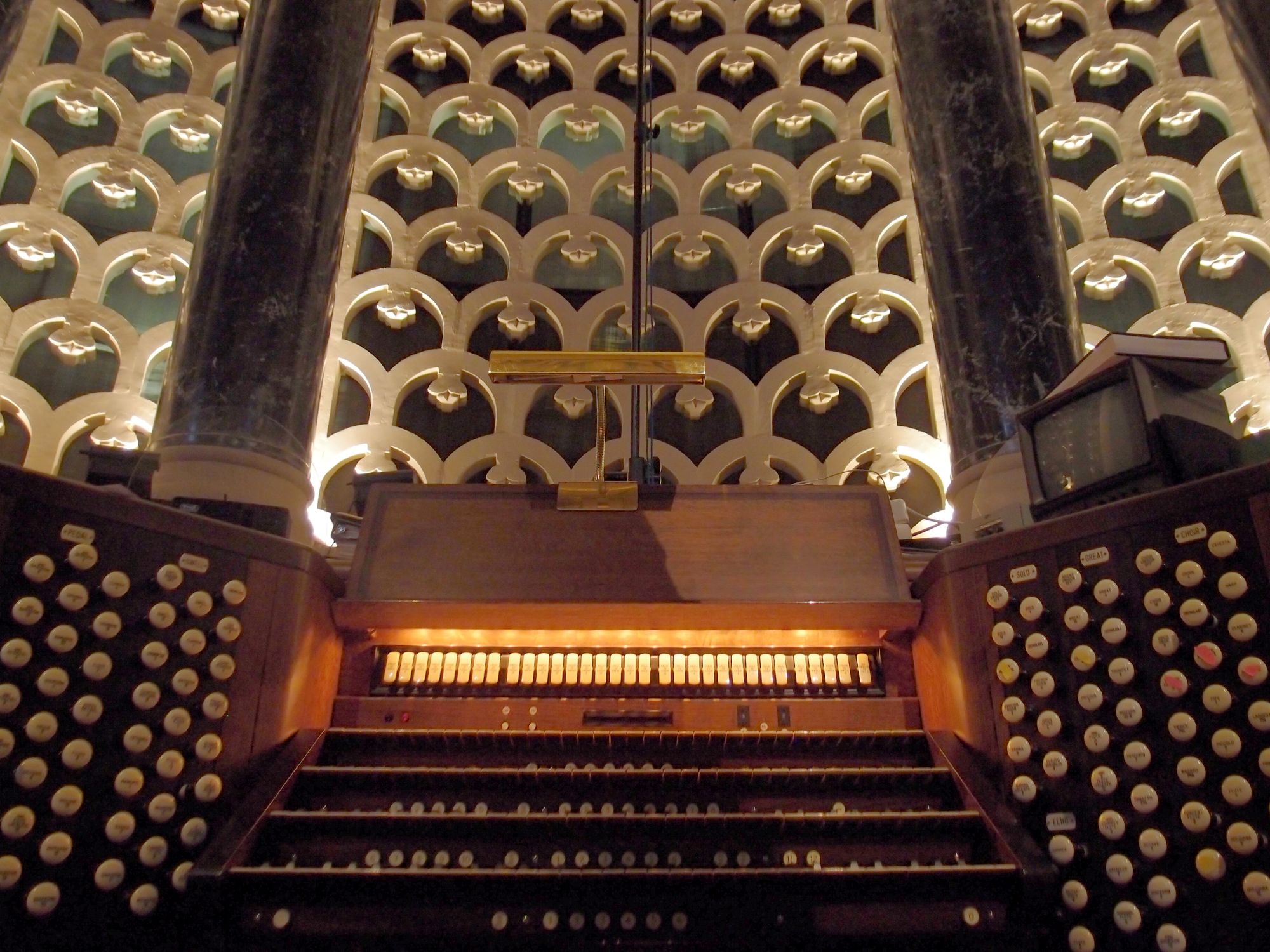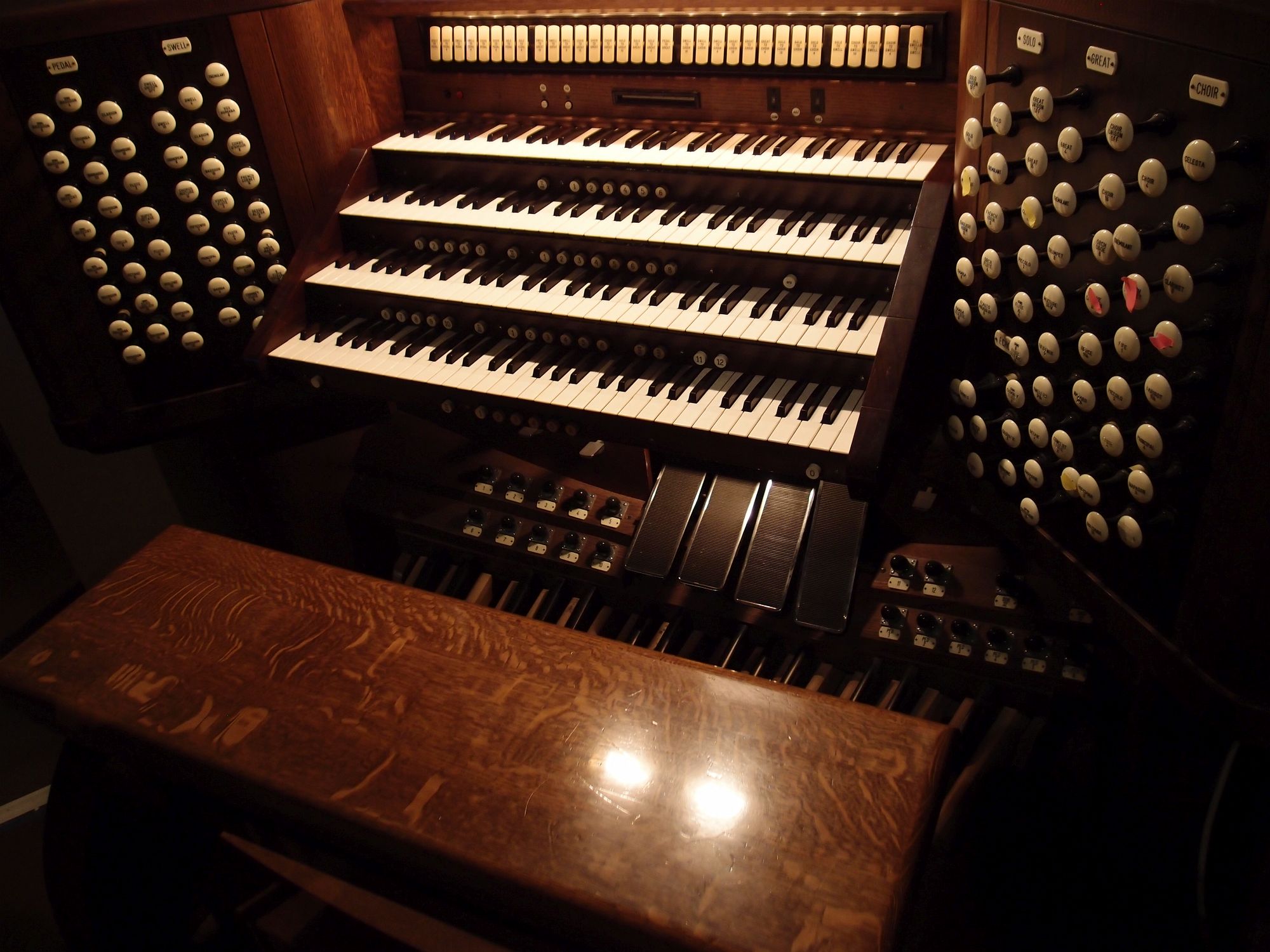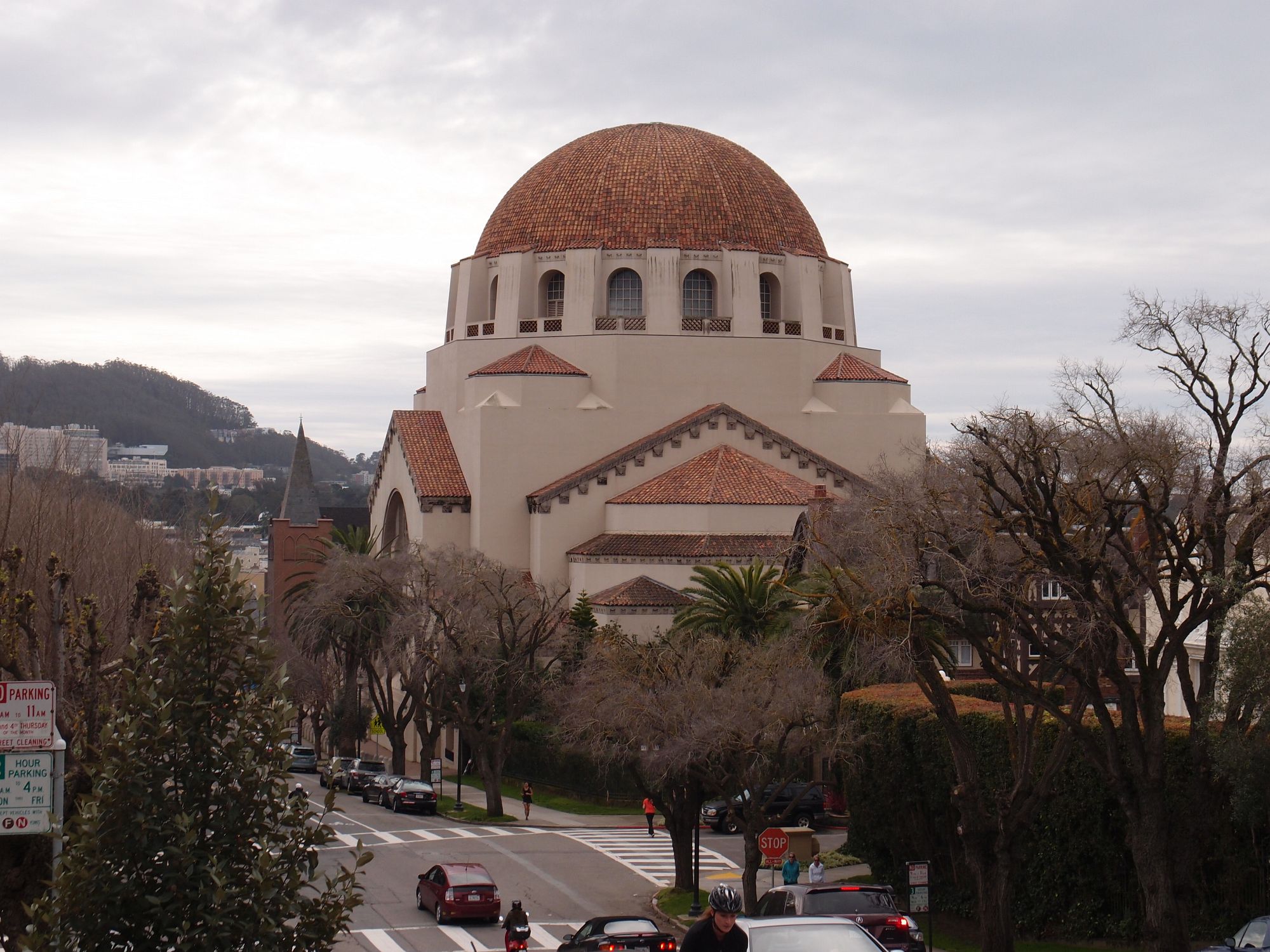San Francisco, California, Temple Emanu-el
| Builder | E. M. Skinner & Company |
|---|---|
| Year | ca. 1924 |
| Period/Style | Modern |
| Stops | 87 |
| Keyboards | 4+P |
| Keyaction | electrical |
| Tuning | Equal at 440 Hz |
| Sampleset |
Available
 , sampled by
Sonus Paradisi
, sampled by
Sonus Paradisi
|
Founded in 1850, Temple Emanu-El is the oldest Jewish congregation west of the Mississippi river. The congregation first gathered for services in a former storage house on Jackson Street until 1865, then in a synagogue built on Sutter Street, and finally in the current building in Presidio Heights. This opulent, neo-byzantine building was inspired by the architecture of Hagia Sofia cathedral and was erected in 1924-1926.
An organ was first used by the San Francisco synagogue in 1857. The Sutter Street Temple built in 1866 also had an organ installed above the altar. The current Skinner organ was manufactured in 1924 at the same time as the new synagogue. This was during the cantorial service of Reuben R. Rinder, who was a key figure for the musical life of the congregation Emanu-El. For example, he started an annual music festival held in the temple where great compositions inspired by Jewish history were performed, such as Handel's Judas Maccabeus or Mendelssohn's Elijah.
The organ has 4 manuals and a pedal (incl. 32' Contrebombarde). The organ's main divisions are located in 5 chambers surrounding the main altar. An echo division is located in a separate chamber at the back of the room. When built, the organ contained 58 ranks. The original stop list can be found on the website of the American Pipe Organ Database. Not much can be tracked reliably about its history, but a few facts are known: In 1926, Skinner himself changed two stops, swapping the Swell Gamba for an Aeoline, and replacing the Gross Bourdon on the Solo for a Flauto Mirabilis. Sometime in the 1960s, the organ was rebuilt and enlarged by Swain & Kates. In 1993, a new console was supplied by Schoenstein. Over its history, the instrument has grown to almost 90 ranks and 88 sounding stops.
Today, the organ represents an American Classic instrument rather than maintaining Skinner's original sound ideal. Skinner's characteristic symphonic sound was changed (or "improved" as those at the time might have said), favoring organ revival aesthetics of the time. For example, two new mixtures were added (one of them replacing the Second Diapason on the Great) and the Choir was changed to become an independent division with its own principal chorus. The fate of the organ seems typical for many other American historical organs. However, most of Skinner's stops are still in place and the changes were done more by adding stops than by subtracting them, thus enriching the possibilities of the instrument. The Skinner base is still recognizable with its abundance of dynamically differentiated foundation stops, restrained upper work, characteristic reeds (French horn, Tuba Mirabilis, Orchestral Oboe, Oboe d'Amour, etc.), but many stops have been revoiced over the years to at least some extent. A particular loss compared to the original specification is the Great Second Diapason, useful for smooth dynamic gradation, and removal of the Septime on Choir with its characteristic tonal color in ensembles.
Much American church music written in the 20th century will sound accurate on an instrument of this kind. For example, the compositions of Richard Purvis (1913-1993) almost seem as if written for this organ. Its disposition fits nearly all of Purvis' registration indications, and given Purvis' time in San Francisco as organist at Grace Cathedral he undoubtedly knew of and played this organ.
An organ was first used by the San Francisco synagogue in 1857. The Sutter Street Temple built in 1866 also had an organ installed above the altar. The current Skinner organ was manufactured in 1924 at the same time as the new synagogue. This was during the cantorial service of Reuben R. Rinder, who was a key figure for the musical life of the congregation Emanu-El. For example, he started an annual music festival held in the temple where great compositions inspired by Jewish history were performed, such as Handel's Judas Maccabeus or Mendelssohn's Elijah.
The organ has 4 manuals and a pedal (incl. 32' Contrebombarde). The organ's main divisions are located in 5 chambers surrounding the main altar. An echo division is located in a separate chamber at the back of the room. When built, the organ contained 58 ranks. The original stop list can be found on the website of the American Pipe Organ Database. Not much can be tracked reliably about its history, but a few facts are known: In 1926, Skinner himself changed two stops, swapping the Swell Gamba for an Aeoline, and replacing the Gross Bourdon on the Solo for a Flauto Mirabilis. Sometime in the 1960s, the organ was rebuilt and enlarged by Swain & Kates. In 1993, a new console was supplied by Schoenstein. Over its history, the instrument has grown to almost 90 ranks and 88 sounding stops.
Today, the organ represents an American Classic instrument rather than maintaining Skinner's original sound ideal. Skinner's characteristic symphonic sound was changed (or "improved" as those at the time might have said), favoring organ revival aesthetics of the time. For example, two new mixtures were added (one of them replacing the Second Diapason on the Great) and the Choir was changed to become an independent division with its own principal chorus. The fate of the organ seems typical for many other American historical organs. However, most of Skinner's stops are still in place and the changes were done more by adding stops than by subtracting them, thus enriching the possibilities of the instrument. The Skinner base is still recognizable with its abundance of dynamically differentiated foundation stops, restrained upper work, characteristic reeds (French horn, Tuba Mirabilis, Orchestral Oboe, Oboe d'Amour, etc.), but many stops have been revoiced over the years to at least some extent. A particular loss compared to the original specification is the Great Second Diapason, useful for smooth dynamic gradation, and removal of the Septime on Choir with its characteristic tonal color in ensembles.
Much American church music written in the 20th century will sound accurate on an instrument of this kind. For example, the compositions of Richard Purvis (1913-1993) almost seem as if written for this organ. Its disposition fits nearly all of Purvis' registration indications, and given Purvis' time in San Francisco as organist at Grace Cathedral he undoubtedly knew of and played this organ.
| 1. Choir | 2. Great Organ | 3. Swell | 4. Solo/Echo | Pédal |
|---|---|---|---|---|
| Dulciana 16' | Bourdon 16' | Bourdon 16' | Flauto Mirabilis 8' | Diapason 32' |
| Diapason 8' | Diapason 8' | Diapason 8' | Gamba 8' | Bourdon 32' |
| Concert Flute 8' | Harmonic Flute 8' | Chimney Flute 8' | Gamba Celeste 8' | Diapason 16' |
| Quintadena 8' | Erzähler 8' | Gamba 8' | Orchestral Flute 4' | Bourdon (GT) 16' |
| Dulciana 8' | Chimney Flute (SW) 8' | Bourdon 8' | Tuba Mirabilis 8' | Dulciana (CH) 16' |
| Unda Maris (SW) 8' | Flute celeste (SW) 8' | Voix Celeste II (8') | French Horn 8' | Echo Lieblich (SW) 16' |
| Principal 4' | Octave 4' | Flute Celeste II (8') | English Horn 8' | Violone 16' |
| Flute 4' | Flute (SW) 4' | Unda Maris II (4') | Muted Viole 8' | Octave 8' |
| Nazard 2 2/3' | Piccolo (CH) 2' | Principal 4' | Flute 8' | Flute 8' |
| Piccolo 2' | Mixture III-V | Flute 4' | Schofar | Cello 8' |
| Larigot 1 1/3' | Trumpet 8' | Fifteenth 2' | Chimes | Bourdon (GT) 8' |
| Tierce 1 3/5' | Clairon 4' | Forest Flute 2' | Dulciana (CH) 8' | |
| Fife 1' | Sesquialtera II | Gedeckt (SW) 8' | ||
| Octave Carillon II | French Cornet V | Superoctave 4' | ||
| Mixture IV | Chorus Mixture V | Bourdon (GT) 4' | ||
| French Trumpet 8' | Basson 16' | Gedeckt (SW) 4' | ||
| Clarinet 8' | Cornopean 8' | Flute 2' | ||
| Orchestral Oboe 8' | Corno d'Amour 8' | Bombarde 32' | ||
| Harp | Vox Humana 8' | Trombone 16' | ||
| Celesta | Clairon 4' | Basson (SW) 16' | ||
| Tromba 8' | ||||
| Basson (SW) 8' | ||||
| Basson (SW) 4' | ||||
| Clairon 4' |
1644086179-Edwards Storybook Tale 0-99 Skinner op-497
0:00
0:00
1644086565-Penfield Invocation 0-99 Skinner op-497
0:00
0:00
1644183466-Stickles At Twilight Skinner op-497
0:00
0:00
1644259501-Hauptwerk recording 2022-02-06-15-36-44 Skinner op-497
0:00
0:00
1644432831-Chopin-Valse-op64-2-SanFrancisco
0:00
0:00
1644433101-Favre-Boogie in Bach-SanFrancisco
0:00
0:00
1644594367-Joplin-The-Entertainer-SanFrancisco
0:00
0:00
https://www.sonusparadisi.cz/en/organs/u-s-a/skinner-opus-497-1924.html
 Pipe Organ Map
Pipe Organ Map



